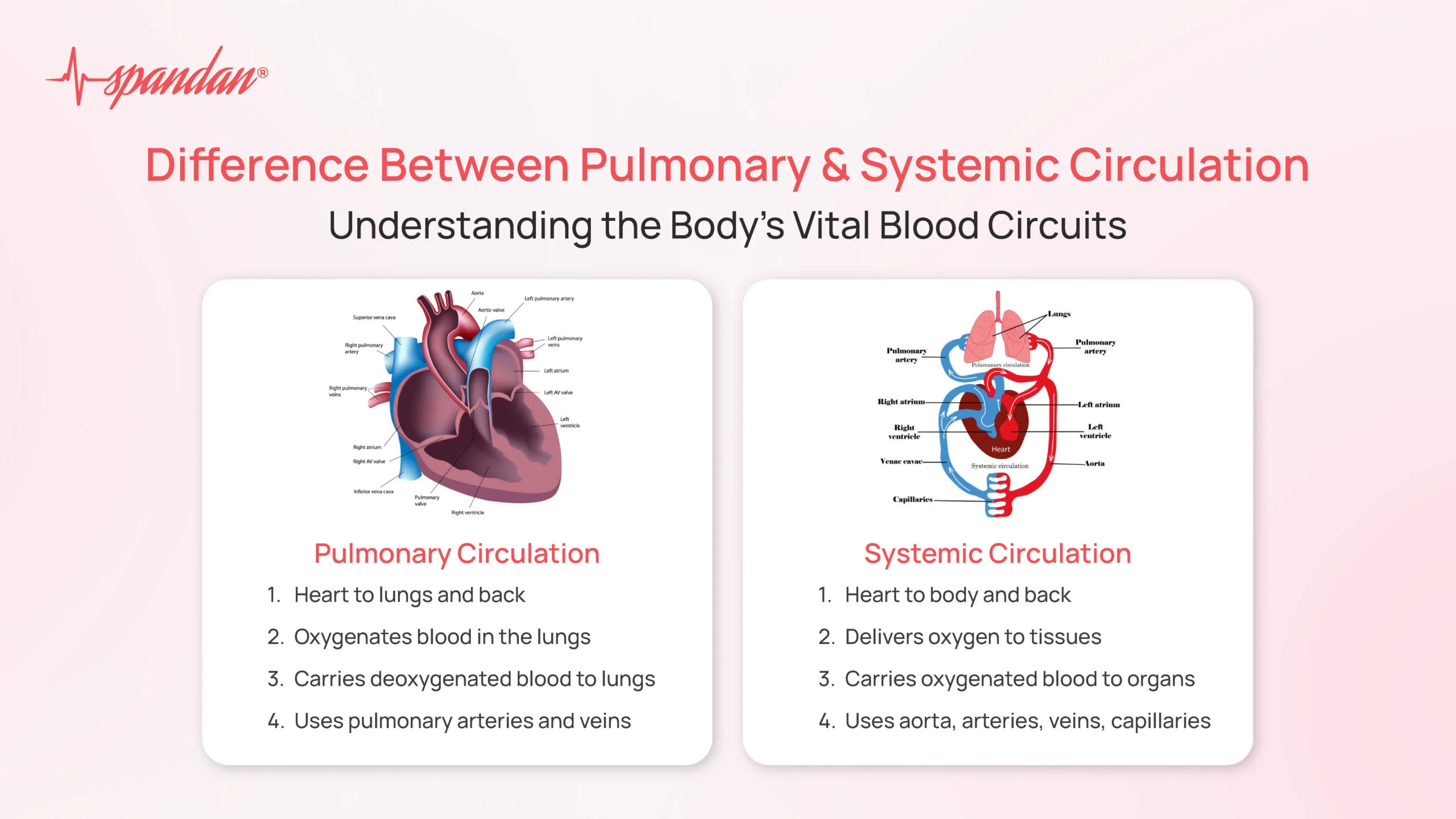
Related Article
Author:- Mr. Ritesh Sharma
The circulatory system plays a pivotal role in maintaining the health and functionality of the human body. At its core, this system is divided into two primary pathways: pulmonary circulation and systemic circulation. The difference between pulmonary and systemic circulation lies in their functions, pathways, and the organs they serve. In this blog, we’ll dive deep into these two essential circulatory processes, understanding their roles in oxygenating blood and delivering nutrients to tissues. By the end, you’ll have a clear grasp of the difference between pulmonary and systemic circulation and why these two systems are vital for life.
What is Circulation?
Before we delve into the difference between pulmonary and systemic circulation, let’s first understand what circulation itself means. Circulation refers to the movement of blood throughout the body, which ensures that oxygen, nutrients, and waste products are efficiently transported to and from tissues and organs. Blood is circulated through two main pathways: pulmonary and systemic, each responsible for different, yet complementary tasks.
Pulmonary Circulation
Pulmonary circulation is the process through which deoxygenated blood is transported from the heart to the lungs and then returned as oxygenated blood to the heart. It is a shorter and more focused circuit compared to systemic circulation, playing a vital role in oxygenating blood before it is distributed to the rest of the body.
Here’s how pulmonary circulation works:
- Deoxygenated Blood Flow: Blood that has delivered oxygen to the body’s tissues returns to the heart’s right atrium through veins. This blood is low in oxygen and high in carbon dioxide.
- Right Ventricle Pumping: From the right atrium, the blood moves to the right ventricle. When the right ventricle contracts, it pushes the blood into the pulmonary arteries.
- Lungs Oxygenation: The pulmonary arteries carry the deoxygenated blood to the lungs. In the lungs, the blood releases carbon dioxide and absorbs oxygen through the alveoli (tiny air sacs).
- Oxygenated Blood Returns: Once oxygenated, the blood returns to the heart’s left atrium through the pulmonary veins, completing the pulmonary circulation.
Pulmonary circulation is crucial for replenishing oxygen levels in the blood and removing carbon dioxide, which is a waste product of metabolism.
Systemic Circulation
Systemic circulation, on the other hand, is responsible for distributing oxygenated blood from the heart to all parts of the body, except the lungs. This pathway ensures that every tissue and organ in the body receives the necessary oxygen and nutrients to function properly, while also collecting waste products like carbon dioxide and bringing them back to the heart.
The process of systemic circulation can be outlined as follows:
- Oxygenated Blood Flow: Once blood has been oxygenated in the lungs, it returns to the left atrium of the heart. From there, it flows into the left ventricle.
- Left Ventricle Pumping: The powerful left ventricle pumps the oxygenated blood into the aorta, the body’s largest artery.
- Blood Distribution: From the aorta, the blood is distributed through a network of arteries to various parts of the body, delivering oxygen and nutrients to cells.
- Waste Collection: As the blood flows through capillaries, it collects waste products like carbon dioxide from tissues. The deoxygenated blood is then transported back to the heart through veins.
- Return to the Heart: The deoxygenated blood eventually returns to the right atrium of the heart, where it is then sent through the pulmonary circulation for oxygenation once again.
Key Difference Between Pulmonary and Systemic Circulation
To fully appreciate the difference between pulmonary and systemic circulation, we need to compare several aspects of these two processes:
- Pathway:
- Pulmonary Circulation: Blood flows from the right side of the heart to the lungs and back to the left side of the heart.
- Systemic Circulation: Blood is pumped from the left side of the heart to the rest of the body and then returns to the right side of the heart.
- Function:
- Pulmonary Circulation: Its primary function is to oxygenate the blood by facilitating gas exchange in the lungs.
- Systemic Circulation: Its role is to deliver oxygen-rich blood to tissues and organs, ensuring they receive the necessary nutrients and oxygen to function.
- Type of Blood:
- Pulmonary Circulation: Transports deoxygenated blood from the heart to the lungs and returns oxygenated blood to the heart.
- Systemic Circulation: Circulates oxygenated blood throughout the body and brings deoxygenated blood back to the heart.
- Pressure:
- Pulmonary Circulation: Operates under low pressure because it only needs to pump blood to the nearby lungs.
- Systemic Circulation: Works under higher pressure as it must pump blood to distant organs and tissues, such as the brain, kidneys, and limbs.
- Distance:
- Pulmonary Circulation: Covers a short distance as it only involves the heart and lungs.
- Systemic Circulation: Covers a much longer distance, supplying blood to the entire body except the lungs.
- Blood Vessels:
- Pulmonary Circulation: Involves the pulmonary arteries and pulmonary veins.
- Systemic Circulation: Involves the aorta, systemic arteries, veins, and capillaries.
Importance of Pulmonary and Systemic Circulation
The importance of both circulatory pathways cannot be overstated. While pulmonary circulation ensures that blood is reoxygenated and ready for systemic circulation, systemic circulation ensures that all organs and tissues receive vital oxygen and nutrients. The difference between pulmonary and systemic circulation highlights how these two systems work together to maintain homeostasis and support bodily functions.
Without efficient pulmonary circulation, the body wouldn’t have access to oxygen, leading to hypoxia (lack of oxygen). Similarly, if systemic circulation were compromised, tissues wouldn’t receive the oxygen and nutrients they need to survive, resulting in organ failure and other serious complications.
Understanding the difference between pulmonary and systemic circulation provides insight into the remarkable way our body ensures that oxygen is supplied to every cell and waste products are removed. Pulmonary circulation focuses on oxygenating the blood, while systemic circulation is tasked with distributing that oxygen-rich blood to tissues and organs. Despite their different roles, these two circulatory pathways work in harmony, ensuring that our bodies remain healthy and functional. By knowing the difference between pulmonary and systemic circulation, we gain a deeper appreciation of the intricate systems that sustain life.




